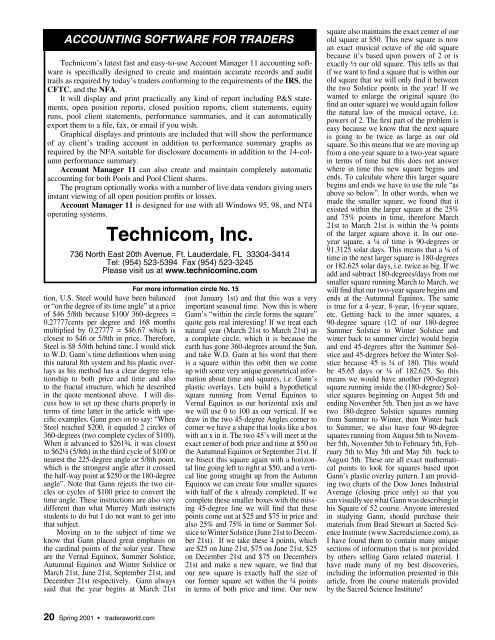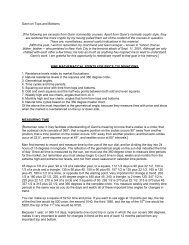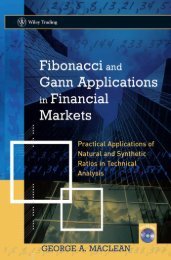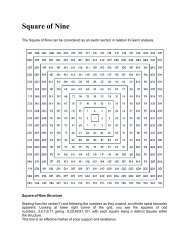You also want an ePaper? Increase the reach of your titles
YUMPU automatically turns print PDFs into web optimized ePapers that Google loves.
ACCOUNTING SOFTWARE FOR TRADERS<br />
Technicom’s latest fast and easy-to-use Account Manager 11 accounting software<br />
is specifi cally designed to create and maintain accurate records and audit<br />
trails as required by today’s traders conforming to the requirements of the IRS, the<br />
CFTC, and the NFA.<br />
It will display and print practically any kind of report including P&S statements,<br />
open position reports, closed position reports, client statements, equity<br />
runs, pool client statements, performance summaries, and it can automatically<br />
export them to a fi le, fax, or email if you wish.<br />
Graphical displays and printouts are included that will show the performance<br />
of ay client’s trading account in addition to performance summary graphs as<br />
required by the NFA suitable for disclosure documents in addition to the 14-column<br />
performance summary.<br />
Account Manager 11 can also create and maintain completely automatic<br />
accounting for both Pools and Pool Client shares.<br />
The program optionally works with a number of live data vendors giving users<br />
instant viewing of all open position profi ts or losses.<br />
Account Manager 11 is designed for use with all Windows 95, 98, and NT4<br />
operating systems.<br />
Technicom, Inc.<br />
736 North East 20th Avenue, Ft. Lauderdale, FL 33304-3414<br />
Tel: (954) 523-5394 Fax (954) 523-3245<br />
Please visit us at www.technicominc.com<br />
tion, U.S. Steel would have been balanced<br />
or “on the degree of its time angle” at a price<br />
of $46 5/8th because $100/ 360-degrees =<br />
0.27777cents per degree and 168 months<br />
multiplied by 0.27777 = $46.67 which is<br />
closest to $46 or 5/8th in price. Therefore,<br />
Steel is $8 5/8th behind time. I would stick<br />
to W.D. Gann’s time defi nitions when using<br />
this natural 8th system and his plastic overlays<br />
as his method has a clear degree relationship<br />
to both price and time and also<br />
to the fractal structure, which he described<br />
in the quote mentioned above. I will discuss<br />
how to set up these charts properly in<br />
terms of time latter in the article with specifi<br />
c examples. Gann goes on to say: “When<br />
Steel reached $200, it equaled 2 circles of<br />
360-degrees (two complete cycles of $100).<br />
When it advanced to $261¾, it was closest<br />
to $62½ (5/8th) in the third cycle of $100 or<br />
nearest the 225-degree angle or 5/8th point,<br />
which is the strongest angle after it crossed<br />
the half-way point at $250 or the 180-degree<br />
angle”. Note that Gann rejects the two circles<br />
or cycles of $100 price to convert the<br />
time angle. These instructions are also very<br />
different than what Murrey Math instructs<br />
students to do but I do not want to get into<br />
that subject.<br />
Moving on to the subject of time we<br />
know that Gann placed great emphasis on<br />
the cardinal points of the solar year. These<br />
are the Vernal Equinox, Summer Solstice,<br />
Autumnal Equinox and Winter Solstice or<br />
March 21st, June 21st, September 21st, and<br />
December 21st respectively. Gann always<br />
said that the year begins at March 21st<br />
20 Spring 2001 tradersworld.com<br />
For more information circle No. 15<br />
(not January 1st) and that this was a very<br />
important seasonal time. Now this is where<br />
Gann’s “within the circle forms the square”<br />
quote gets real interesting! If we treat each<br />
natural year (March 21st to March 21st) as<br />
a complete circle, which it is because the<br />
earth has gone 360-degrees around the Sun,<br />
and take W.D. Gann at his word that there<br />
is a square within this orbit then we come<br />
up with some very unique geometrical information<br />
about time and squares, i.e. Gann’s<br />
plastic overlays. Lets build a hypothetical<br />
square running from Vernal Equinox to<br />
Vernal Equinox as our horizontal axis and<br />
we will use 0 to 100 as our vertical. If we<br />
draw in the two 45-degree Angles corner to<br />
corner we have a shape that looks like a box<br />
with an x in it. The two 45’s will meet at the<br />
exact center of both price and time at $50 on<br />
the Autumnal Equinox or September 21st. If<br />
we bisect this square again with a horizontal<br />
line going left to right at $50, and a vertical<br />
line going straight up from the Autumn<br />
Equinox we can create four smaller squares<br />
with half of the x already completed. If we<br />
complete these smaller boxes with the missing<br />
45-degree line we will fi nd that these<br />
points come out at $25 and $75 in price and<br />
also 25% and 75% in time or Summer Solstice<br />
to Winter Solstice (June 21st to December<br />
21st). If we take these 4 points, which<br />
are $25 on June 21st, $75 on June 21st, $25<br />
on December 21st and $75 on Decembers<br />
21st and make a new square, we fi nd that<br />
our new square is exactly half the size of<br />
our former square set within the ¼ points<br />
in terms of both price and time. Our new<br />
square also maintains the exact center of our<br />
old square at $50. This new square is now<br />
an exact musical octave of the old square<br />
because it’s based upon powers of 2 or is<br />
exactly ½ our old square. This tells us that<br />
if we want to fi nd a square that is within our<br />
old square that we will only fi nd it between<br />
the two Solstice points in the year! If we<br />
wanted to enlarge the original square (to<br />
fi nd an outer square) we would again follow<br />
the natural law of the musical octave, i.e.<br />
powers of 2. The fi rst part of the problem is<br />
easy because we know that the next square<br />
is going to be twice as large as our old<br />
square. So this means that we are moving up<br />
from a one-year square to a two-year square<br />
in terms of time but this does not answer<br />
where in time this new square begins and<br />
ends. To calculate where this larger square<br />
begins and ends we have to use the rule “as<br />
above so below”. In other words, when we<br />
made the smaller square, we found that it<br />
existed within the larger square at the 25%<br />
and 75% points in time, therefore March<br />
21st to March 21st is within the ¼ points<br />
of the larger square above it. In our oneyear<br />
square, a ¼ of time is 90-degrees or<br />
91.3125 solar days. This means that a ¼ of<br />
time in the next larger square is 180-degrees<br />
or 182.625 solar days, i.e. twice as big. If we<br />
add and subtract 180-degrees/days from our<br />
smaller square running March to March, we<br />
will fi nd that our two-year square begins and<br />
ends at the Autumnal Equinox. The same<br />
is true for a 4-year, 8-year, 16-year square,<br />
etc. Getting back to the inner squares, a<br />
90-degree square (1/2 of our 180-degree<br />
Summer Solstice to Winter Solstice and<br />
winter back to summer circle) would begin<br />
and end 45-degrees after the Summer Solstice<br />
and 45-degrees before the Winter Solstice<br />
because 45 is ¼ of 180. This would<br />
be 45.65 days or ¼ of 182.625. So this<br />
means we would have another (90-degree)<br />
square running inside the (180-degree) Solstice<br />
squares beginning on August 5th and<br />
ending November 5th. Then just as we have<br />
two 180-degree Solstice squares running<br />
from Summer to Winter, then Winter back<br />
to Summer, we also have four 90-degree<br />
squares running from August 5th to November<br />
5th, November 5th to February 5th, February<br />
5th to May 5th and May 5th back to<br />
August 5th. These are all exact mathematical<br />
points to look for squares based upon<br />
Gann’s plastic overlay pattern. I am providing<br />
two charts of the Dow Jones Industrial<br />
Average (closing price only) so that you<br />
can visually see what Gann was describing in<br />
his Square of 52 course. Anyone interested<br />
in studying Gann, should purchase their<br />
materials from Brad Stewart at Sacred Science<br />
Institute (www.Sacredscience.com), as<br />
I have found them to contain many unique<br />
sections of information that is not provided<br />
by others selling Gann related material. I<br />
have made many of my best discoveries,<br />
including the information presented in this<br />
article, from the course materials provided<br />
by the Sacred Science Institute!






